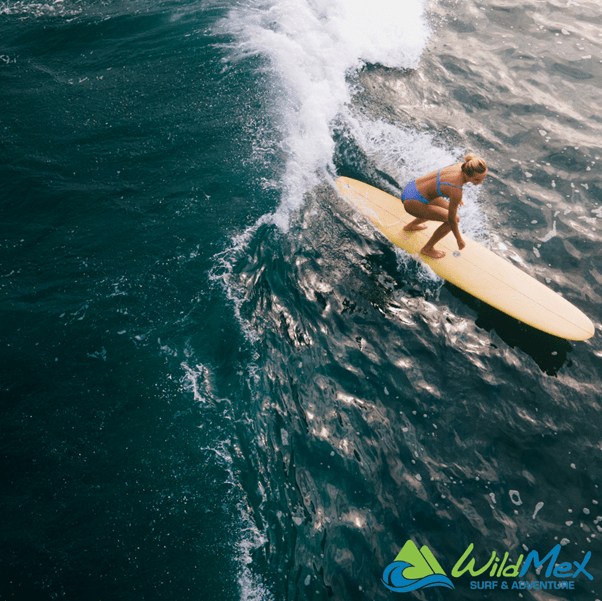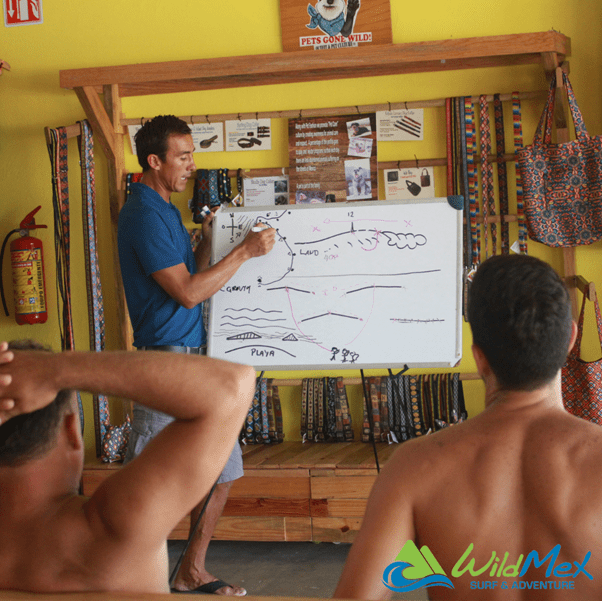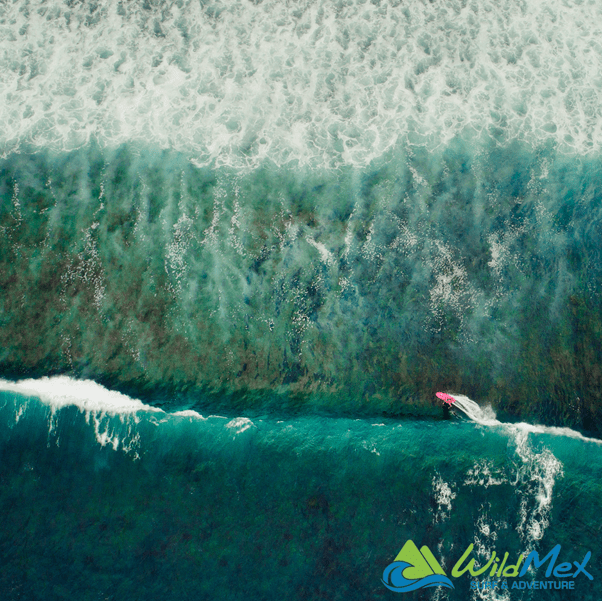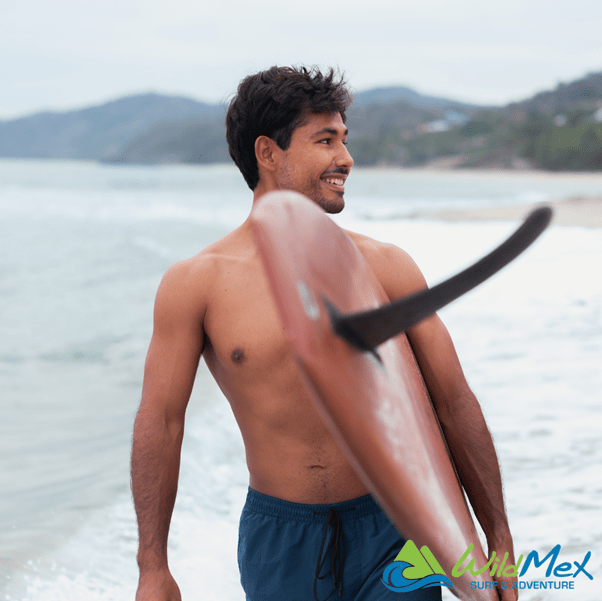Surfing Etiquette 101 – Becoming the Good Kind of Surfer
 Our WildMex Surf Camp In Sayulita and Punta Mita teaches true surf etiquette so you can think like a pro even before your first lesson.
Our WildMex Surf Camp In Sayulita and Punta Mita teaches true surf etiquette so you can think like a pro even before your first lesson.Surf Lessons In Punta Mita!
 You’ll learn how to read tides, waves and learn the best time to surf Punta Mita & Sayulita waves in our Wild Mex surf camp.
You’ll learn how to read tides, waves and learn the best time to surf Punta Mita & Sayulita waves in our Wild Mex surf camp.The Basics of Surfing: All the Theory with a Twist!
Experienced surfers will accumulate a lot of time in the water, this means that they have learned to gauge which waves will break and which waves are the best to catch. They also know when is the best time to surf Punta Mita waves because they know the tides, swells and how to avoid the competitive crowds.
However, surfing for beginners in Punta Mita or Sayulita can seem overwhelming when you can’t keep up with all the surfer terms. So, here are some of the basics and theories that you need to know before your first class at your Surf Camp in Punta Mita and Sayulita with WildMex!
1) Learning the Wave Directions
To have good surf, the first thing you'll need to learn is to understand how swells work and which waves are the best ones to get familiar with. Once you start your surf lessons in Punta Mita or Sayulita, you will begin to hear your coach and other surfers use the terms listed below, take a read and get familiar with them, knowing the lingo may be the difference between you catching 0 waves or 10!
The Direction of the Wind
Offshore wind - what surfers' dreams are made of. Offshore wind is the kind that blows from the land to the ocean, this is the best kind for surfing. It produces waves that are clean and groomed and indicate the best time to surf Punta Mita, Sayulita, or any other waves for that matter. Also, a swell coming in from the north will break differently than a swell arriving from the south. It’s important to point out that it is also possible to surf when the wind is Onshore, the kind that blows from ocean to land, however, this is the worst wind for surfing. The wind blows in from the ocean and ensures that all the waves crumble and have no shape, making the waves prettttty hard to surf!
Tide
Gauging the tide is important to catch the best waves. Some beaches work best on low tide and others on high tide. Different tides can either make waves "mushy"; breaking slowly with a lip that just sort of crumbles over when the wave breaks, or "hollow"; fast-breaking, barreling waves with lips that pitch out forcefully into the wave's trough. You’ll learn the local tides from your coach once you arrive here!
The Best Kinds
The types of waves that you experience while surfing in Punta Mita and Sayulita are beach breaks, pointbreaks, and reef breaks. These waves all have their own characteristics:
| Waves | Pros | Cons |
|---|---|---|
| Beach Breaks | Beach Breaks tend to be common, with consistent waves and nice sand bottoms. | Beach Breaks can be unforgiving, with difficult paddle-outs |
| Pointbreaks | Pointbreaks can offer perfectly shaped waves and the longest rides of any kind of wave. | Pointbreaks can get a little too crowded sometimes and are generally not that consistent |
| Reef Breaks | Reef Breaks Reef Breaks are where advanced surfers go in search of the best barrels. Reef Breaks usually have uneven and/or sharp bottoms composed of rock or coral. | Reef Breaks usually have uneven and/or sharp bottoms composed of rock or coral. |
But drawbacks aside, all these types of waves can offer excellent surf, and as any dedicated surfer will tell you, the rewards of surfing are worth more than material wealth.
Lefts and Rights
Understanding where the wave will break is impossible if you haven’t had any or little experience with surfing.
Waves “peel” to either the left or the right. As a beginner learning to Surf in Punta Mita and Sayulita there is a simple way to tell the difference between the two “peels”.
When you're lying down on your surfboard, paddling into a wave, you're going to drop into the wave and angle either towards your right with the wave crashing to your left (then it’s a right-hander) or you're left with the wave crashing to your right (which tells us it’s a left-hander).
If you’re watching from the shore, a surfer surfing in Punta Mita going left means they’re riding a right peeling wave. Don’t worry if you don’t get it yet, you will find it obvious the minute you see it for yourself!
Rip Tides
Another terminology that you might hear a lot when you’re learning to Surf in Punta Mita and Sayulita is rip currents or rip tides. While this term might sound dangerous, and it is, but only for those unfamiliar with how they work, yet for those who follow a few basic rules, rips are nothing to fear!
A rip is a path of water being pushed onto the shore by the waves takes to run back into the ocean, they can often appear as deeper and darker colored water in a relatively calm or rippled channel between breaking waves. However, these channels actually indicate fast currents moving back out to sea. One sign to spot one may be noticing anything floating out to sea via that route.
Rip currents can be dangerous because people can become exhausted trying to swim against the current back to shore, however, many surfers use this channel to enter the ocean from the shore or get back out the back after catching a wave. The way to escape the channel once you get out the back is by swimming parallel to the shore to escape the rip current. Never swim against the current back to shore.

2) Sets
Set waves are those waves that come in larger than the overall significant wave height. In this case, it is quite probable that you’ll have a wipeout one time or another.
To try and avoid a wipeout, once you see a set coming (a good indication of this is seeing all other surfers paddling out fast), you should follow them and paddle out too in the opposite direction of wherever the wave is peeling from.
If you run out of time and you see the wave is about to crash on you, always opt for a turtle roll, also known as the Eskimo roll, a surfing technique that allows you to get past the breaking waves without having to discard your surfboard or duck dive in challenging conditions. You’ll learn how to do this at your surf camp in Sayulita and Punta Mita.
3) Wipe Outs
Let’s talk realistically, wipeouts are what you’re fearing the most. But stop! Wipeouts are common, even for expert surfers, and if you learn how to tackle them you will be safe!
If you do get hit by a wave and held underwater, never panic and scratch hard for the surface! It doesn't matter if you only managed to get just half a lungful of air, you'll be alright if you just simply relax. In the words of a surfer:
“Relaxing may not seem easy when you’ve encountered your first wipeout. Every second underwater might feel like ten, but even on a powerful wave, you'll be underwater for no more than five to ten seconds. So, when the wave is starting to recede, you can come back up and BREATHE…”
Pro Tip: Your Surfboard is your Best Friend!
Don't forget that your surfboard isn't just for riding waves, it is also an excellent lifesaving device and your primary means of getting out of trouble should a bad situation arise. So, don’t ditch it unless it is extremely necessary.
4) Crowding and Surfing Etiquette
Another concept you would want to learn before you get started with the waves is surfer etiquette.
If you take off on a wave in front of someone, you're basically stealing the wave, as the surfer who was already up and riding has to give up the wave or risk having a collision with you.
And not just collisions, one wave ridden by two persons is trouble! If you’re at the back and the surfer in front of you rides away while you’re at the end-side of the wave, you’ll experience a pretty blatant drop-in.
And the easiest way to avoid drop-ins is simple - stay away from crowds! Crowds tend to get competitive, and there are always those in the water who don't care so much about having fun as they do about showing off and catching all the waves they can.
Always give way to the surfer closest to the highest point of the wave (the peak). They have the right of way on the wave.

Summing it Up
To sum up our crash course, don’t forget to have fun!
The best thing you can do for both yourself and others in the water is simple - just respect others and enjoy yourself! It's hard not to have a good time in the surf, but everyone has a bad day every once in a while.
But hey, don’t worry, be happy! Remember to always stay in a relaxed frame of mind, and encourage others to do the same. Share waves, smile, and give a kind word to both friends and strangers alike. Hoot for others when you see them get a good wave, and soon you'll hear other surfers hooting for you on your good ones too!
We can’t wait to welcome you to the waves!
Peace & love,
Wild Mex
